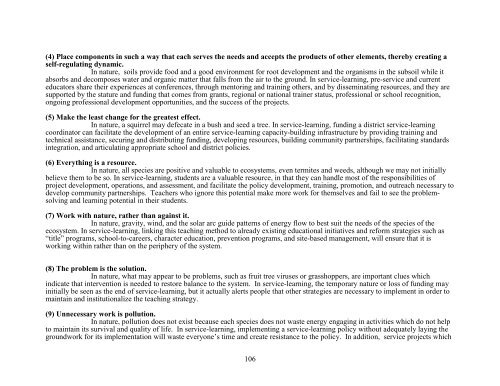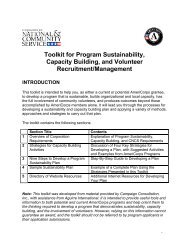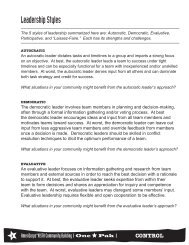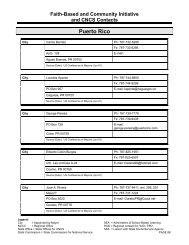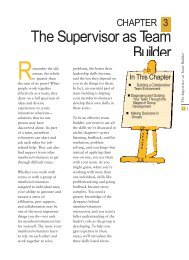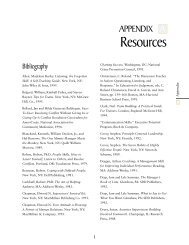MAKE IT LAST FOREVER: THE ... - National Service Resource Center
MAKE IT LAST FOREVER: THE ... - National Service Resource Center
MAKE IT LAST FOREVER: THE ... - National Service Resource Center
Create successful ePaper yourself
Turn your PDF publications into a flip-book with our unique Google optimized e-Paper software.
(4) Place components in such a way that each serves the needs and accepts the products of other elements, thereby creating a<br />
self-regulating dynamic.<br />
In nature, soils provide food and a good environment for root development and the organisms in the subsoil while it<br />
absorbs and decomposes water and organic matter that falls from the air to the ground. In service-learning, pre-service and current<br />
educators share their experiences at conferences, through mentoring and training others, and by disseminating resources, and they are<br />
supported by the stature and funding that comes from grants, regional or national trainer status, professional or school recognition,<br />
ongoing professional development opportunities, and the success of the projects.<br />
(5) Make the least change for the greatest effect.<br />
In nature, a squirrel may defecate in a bush and seed a tree. In service-learning, funding a district service-learning<br />
coordinator can facilitate the development of an entire service-learning capacity-building infrastructure by providing training and<br />
technical assistance, securing and distributing funding, developing resources, building community partnerships, facilitating standards<br />
integration, and articulating appropriate school and district policies.<br />
(6) Everything is a resource.<br />
In nature, all species are positive and valuable to ecosystems, even termites and weeds, although we may not initially<br />
believe them to be so. In service-learning, students are a valuable resource, in that they can handle most of the responsibilities of<br />
project development, operations, and assessment, and facilitate the policy development, training, promotion, and outreach necessary to<br />
develop community partnerships. Teachers who ignore this potential make more work for themselves and fail to see the problemsolving<br />
and learning potential in their students.<br />
(7) Work with nature, rather than against it.<br />
In nature, gravity, wind, and the solar arc guide patterns of energy flow to best suit the needs of the species of the<br />
ecosystem. In service-learning, linking this teaching method to already existing educational initiatives and reform strategies such as<br />
“title” programs, school-to-careers, character education, prevention programs, and site-based management, will ensure that it is<br />
working within rather than on the periphery of the system.<br />
(8) The problem is the solution.<br />
In nature, what may appear to be problems, such as fruit tree viruses or grasshoppers, are important clues which<br />
indicate that intervention is needed to restore balance to the system. In service-learning, the temporary nature or loss of funding may<br />
initially be seen as the end of service-learning, but it actually alerts people that other strategies are necessary to implement in order to<br />
maintain and institutionalize the teaching strategy.<br />
(9) Unnecessary work is pollution.<br />
In nature, pollution does not exist because each species does not waste energy engaging in activities which do not help<br />
to maintain its survival and quality of life. In service-learning, implementing a service-learning policy without adequately laying the<br />
groundwork for its implementation will waste everyone’s time and create resistance to the policy. In addition, service projects which<br />
106


